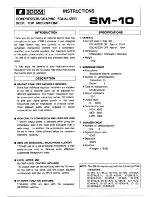
7
LOGIC INPUTS
Sixteen Logic Inputs are available on a rear panel 25-pin Sub-D (female) connector. Logic Inputs allow remote control of preset selection
via external circuits, such as switches, contact-closures, active driver circuits, and/or ‘open-collector’ logic outputs. From the factory, Logic
Inputs 1~8 are programmed to recall presets 1~8 respectively (Channel 1 on an EQ282/8). On an EQ282/8, Logic Inputs 9~16 are
programmed to recall presets 1~8 for Channel 2. On an EQ281/8, Logic Inputs 9~16 are programmed to do nothing. However, Logic
Inputs may be individually programmed to perform other functions, using the PC Control Software and serial cable provided with the
equalizer (see Setup on pg. 4). Since Logic Inputs are controlled by switches, contact-closures, etc., each Logic Input may be assigned
two functions (one for switch ‘closed’ and one for switch ‘open’). Logic Inputs may be programmed to have no effect on the equalizer, but
instead trigger ASCII characters which affect other ADVANTAGE
®
products via RS-232 (see RS-232 Control on pg. 8).
Logic Inputs have the following pin assignments (right-to-left & top-to-bottom): Pins 1~16) Logic Inputs 1~16; Pins 17~25) Ground.
Pins Functions Factory Programming
#1~8 Logic Inputs 1~8 Preset Select 1~8 (channel 1 - EQ282/8)
#9~16 Logic Inputs 9~16 Preset Select 1~8 (channel 2 - EQ282/8)
#17~25 common ground switch ground points (not programmable)
1
2
3
4
5
14
15
16
17
6
18
7
19
8
20
9
21
10
22
11
23
12
24
13
25
logic inputs
When nothing is connected to a Logic Input, an internal pull-up resistor keeps it at a ‘high’ idle state (+5.0 VDC). The Logic Input is
activated when its input goes ‘low’ (less than +0.8 VDC), and is de-activated when its input goes ‘high’ (greater than +2.4 VDC). A Logic
Input is controlled in one of three ways: 1) Use an NPN style ‘open-collector’ logic output from an external device (such as an
ADVANTAGE
®
PMX84 or DRC4+4) to short the Logic Input to ground. 2) Use a switch, relay, or other contact-closure (such as from a
third-party controller) to short the Logic Input to ground. 3) Use an active TTL output driver circuit (such as from a third-party controller) to
actively drive the Logic Input to a ‘high’ or ‘low’ state.
Multiple contact-closures or ‘open-collector’ logic outputs or may be wired in parallel to a single Logic Input (see diagram below). Likewise,
a single contact-closure or ‘open-collector’ logic output may be wired in parallel to multiple Logic Inputs. However, these circumstances
may be rare, since the Logic Inputs can be individually programmed for specific preset selections. Logic Outputs and contact-closures
should be rated for at least 5 Volts / 1mA operation. Low-current / dry-contact closures are recommended for reliability. Active output
driver circuits should not exceed a signal range of 0~5 Volts DC, and should have a minimum pulse width of 100 milli-seconds. Logic Input
impedances are approximately 10k ohms.
multiple switches to single Logic Input
single switch to multiple Logic Inputs
(momentary switches recommended)
































